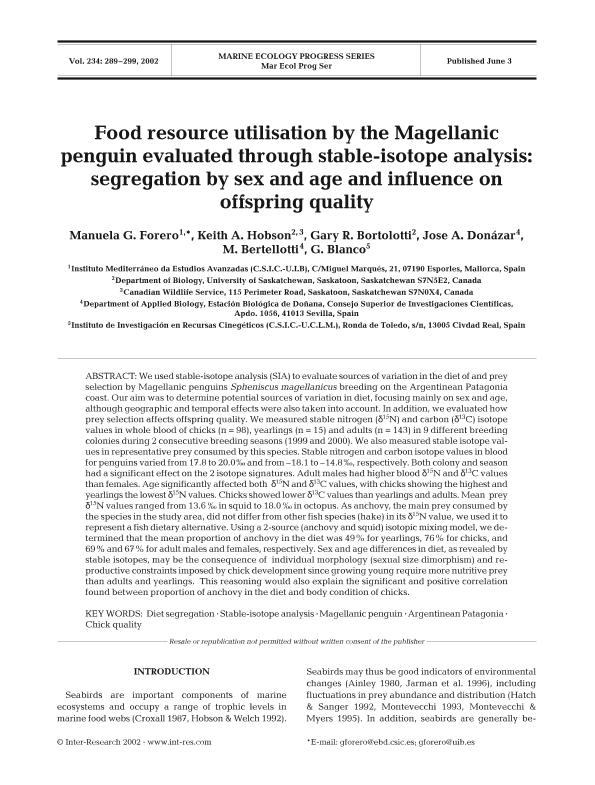Artículo
Food resource utilisation by the Magellanic penguin evaluated through stable-isotope analysis: Segregation by sex and age and influence on offspring quality
Forero, Manuela G.; Hobson, Keith A.; Bortolotti, Gary R.; Donázar, Jose A.; Bertellotti, Néstor Marcelo ; Blanco, G.
; Blanco, G.
 ; Blanco, G.
; Blanco, G.
Fecha de publicación:
06/2002
Editorial:
Inter-Research
Revista:
Marine Ecology Progress Series
ISSN:
0171-8630
Idioma:
Inglés
Tipo de recurso:
Artículo publicado
Clasificación temática:
Resumen
We used stable-isotope analysis (SIA) to evaluate sources of variation in the diet of and prey selection by Magellanic penguins Spheniscus magellanicus breeding on the Argentinean Patagonia coast. Our aim was to determine potential sources of variation in diet, focusing mainly on sex and age, although geographic and temporal effects were also taken into account. In addition, we evaluated how prey selection affects offspring quality. We measured stable nitrogen (δ15N) and carbon (δ13C) isotope values in whole blood of chicks (n = 98), yearlings (n = 15) and adults (n = 143) in 9 different breeding colonies during 2 consecutive breeding seasons (1999 and 2000). We also measured stable isotope values in representative prey consumed by this species. Stable nitrogen and carbon isotope values in blood for penguins varied from 17.8 to 20.0‰ and from -18.1 to -14.8‰, respectively. Both colony and season had a significant effect on the 2 isotope signatures. Adult males had higher blood δ15N and δ13C values than females. Age significantly affected both δ15N and δ13C values, with chicks showing the highest and yearlings the lowest δ15N values. Chicks showed lower δ13C values than yearlings and adults. Mean prey δ15N values ranged from 13.6‰ in squid to 18.0‰ in octopus. As anchovy, the main prey consumed by the species in the study area, did not differ from other fish species (hake) in its δ15N value, we used it to represent a fish dietary alternative. Using a 2-source (anchovy and squid) isotopic mixing model, we determined that the mean proportion of anchovy in the diet was 49% for yearlings, 76% for chicks, and 69% and 67% for adult males and females, respectively. Sex and age differences in diet, as revealed by stable isotopes, may be the consequence of individual morphology (sexual size dimorphism) and reproductive constraints imposed by chick development since growing young require more nutritive prey than adults and yearlings. This reasoning would also explain the significant and positive correlation found between proportion of anchovy in the diet and body condition of chicks.
Archivos asociados
Licencia
Identificadores
Colecciones
Articulos(CCT-CENPAT)
Articulos de CTRO.CIENTIFICO TECNOL.CONICET - CENPAT
Articulos de CTRO.CIENTIFICO TECNOL.CONICET - CENPAT
Citación
Forero, Manuela G.; Hobson, Keith A.; Bortolotti, Gary R.; Donázar, Jose A.; Bertellotti, Néstor Marcelo; et al.; Food resource utilisation by the Magellanic penguin evaluated through stable-isotope analysis: Segregation by sex and age and influence on offspring quality; Inter-Research; Marine Ecology Progress Series; 234; 6-2002; 289-299
Compartir
Altmétricas



